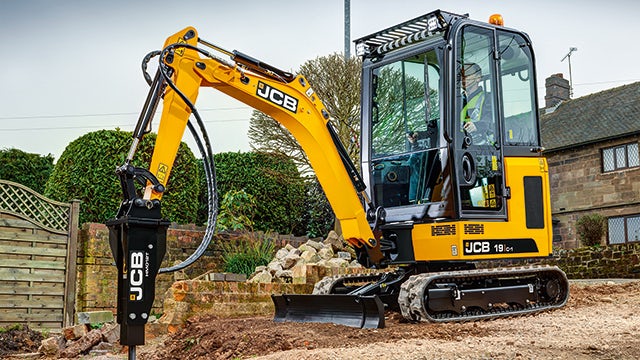Heavyweight manufacturer drives digitalization
With Siemens Digital Industries Software solutions, JCB digs out the detail required for continuous improvement
JCB
JCB is one of the world’s top three manufacturers of construction equipment. A family-owned company, it employs around 12,000 people on four continents and sells products in 150 countries through 2,000 dealer depot locations. JCB invests heavily in research and development, is known for innovation and has some of the finest engineering facilities across the globe. The company produces a range of more than 300 machines and maintains a reputation for unrivaled customer service.
https://www.jcb.com- Headquarters:
- Rocester, United Kingdom
- Products:
- Geolus, NX, PLM Components, Teamcenter
- Industry Sector:
- Heavy equipment
NX is a very powerful tool, always evolving…
JCB
From a garage to a global brand
JCB has become a household name across the world for its distinctive yellow loaders, excavators and tractors. It is possible, however, to order a JCB machine in bright pink. In fact, there are thousands of potential variations to suit all operational and climatic requirements.
family-owned company established in a garage in 1945, JCB now employs 12,000 people, has more than 2,000 dealerships, sells its range of 300 products in more than 150 countries and launches 50 to 60 product updates per year. Teamcenter® software and NX™ software from product lifecycle management (PLM) specialist Siemens Digital Industries Software play a key role in JCB’s continuing success.
Accurate and accessible digital information
Within the company’s innovation studio, the focus is on new product development as researchers, designers and ergonomists explore issues such as health and safety, driver comfort, functionality, reliability, fuel efficiency and maintenance costs. The studio iterates with engineering teams who use NX to design parts, and once a concept design is approved, Teamcenter manages the release of all data and generates bills of materials (BOMs).
“Teamcenter is the backbone for our development process, connecting the innovation studio with engineering, manufacturing, distribution and servicing,” says Phil Layton, general manager of engineering programs at JCB. “Our use of Teamcenter is helping to deliver standardization and communication across the group, enabling efficiency and speed. However, we are always looking to improve the way that systems and processes support our global business, particularly the way in which we configure products.”
Andrew Lodge, head of engineering systems, adds: “Our aim is to reduce nonvalue added tasks, and designing a new part when an existing part could be re-used is a clear example of this. We identified that existing parts are sometimes named, coded or stored incorrectly, partly because various teams have historically kept some of their own key statistical information on departmental spreadsheets. Not only were these spreadsheets inconsistent in style, they were often quite complicated.”
It became a priority for JCB to gather together these disparate silos of information, enable easy re-use of parts, develop a more efficient product configurator and improve the monitoring of performance. Working closely with Siemens Digital Industries Software, JCB has been focusing on these three areas.

Easily and quickly re-use parts
“Twelve percent of the parts we make each year are totally new and we are looking to get this down to five percent by increasing the re-use of parts,” explains Lodge. “The ability to locate existing parts more easily is critical, and we wanted a tool that would provide a search function in the style of commercial online retailers. We were looking for a global solution with simple language and consistent naming. The answer for us was clearly Geolus, the 3D geometry search engine from Siemens Digital Industries Software.”
All users involved in JCB’s new product introduction process can now search by shape in Geolus® software to understand if a similar part has already been created before attempting the design of a new one; this functionality is also used by non-CAD users. Geolus is being built into all of the company’s systems and processes to enable monitoring of re-use and the phase-out of redundant parts. “This shape search tool allows us to very quickly identify common or similar size and shape parts instead of having to trawl through the extensive database,” notes Lodge.
“Geolus Shape Search helps us to find parts much more quickly and helps us to redesign and re-use already existing components.”
By tying in the use of Geolus with established procedures for new product development, JCB has a system that encourages ownership by users. “We have established Geolus as a searchable store that gives the weight and size of parts,” Lodge continues. “Now we are improving it by adding images, test results and performance reviews all on one page. Users are required to declare that they have used the Geolus shape search toolset and report on their own level of re-use. Teamcenter reporting and analytics will then provide definitive statistics on part re-use.”

Developing an efficient product configurator
With 200,000 possible product variations, product configuration is a very complex process for JCB. Configuration had historically been accomplished using an array of spreadsheets, which required careful management by one key operator. With this manual method of specifying different parts it was not possible to identify issues that could arise when assembling them all together. There was also no easy means of checking for simple errors such as specifying air conditioning for a cold climate or for an open cabin without any glass.
This was the opportunity for JCB to marry its extensive know-how on all product options and variants with the technical expertise of the Siemens Digital Industries Software consultants in order to implement Teamcenter Product Configurator. This brings all the possible product options and variants together in one place, creating the equivalent of a 600 percent BOM per product range or family and enabling the accurate selection of every item needed to configure any variation for a given product order.
“We’ll be able to commonize build across the business units and control our configuration and variants with much greater ease,” Lodge notes. “This is going to allow us to check and validate our variations and our build before they hit the shop floor.”

A clear view with reporting and analytics
“We have all the information, and we are working out where it is and how to bring it into Teamcenter,” explains Lodge. “We have a clear roadmap for transferring our extensive, labor-intensive legacy data into Teamcenter, and once everyone is doing the same thing, reporting will become easier and quicker. We’ll learn from each other and we’ll be able to respond more speedily. We will be able to track problems and countermeasures on a global basis, use Geolus to identify parts that need to be investigated, work out common causes and share the results through Teamcenter.”

Collaboration supports constant improvement
“We look at Siemens Digital Industries Software as a partner, not a commodity supplier,” Lodge comments. “We are in a long-term relationship which focuses on driving up quality. Across JCB, the use of Teamcenter is gradually expanding and teams are looking at how they can gain more from the Siemens PLM tools.”
Comprehensive use of the digital twin throughout development enables JCB to continue to make improvements, particularly within the innovation studio. Ben Watson, group head of industrial design, says: “The challenge for any manufacturer is about having confidence in the design before proceeding to tooling. We are constantly looking at ways to achieve more confidence, and for some time we have been looking at virtual reality (VR) tools that would allow us to appreciate the size and feel of a product, right down to the sensation of a digger hitting the soil.”
Richard Biddulph, studio manager, adds: “NX is a very powerful tool, always evolving, and we are looking at using more visualization tools to communicate with engineering. If we could, for example, take engineering data into VR and bring it to life we would really own it.”
“Digitalization allows JCB to spot errors and prove designs much, much earlier in the design process,” says Lodge. Stuart Hughes, chief information officer concludes: “JCB is known for innovation and a long-term outlook. By enabling teams to own, operate and enhance working practices, the company is continually improving, and the Siemens PLM platform is fundamental to our future.”
Geolus helps us to find parts much more quickly and helps us to redesign and re-use already existing components.
JCB